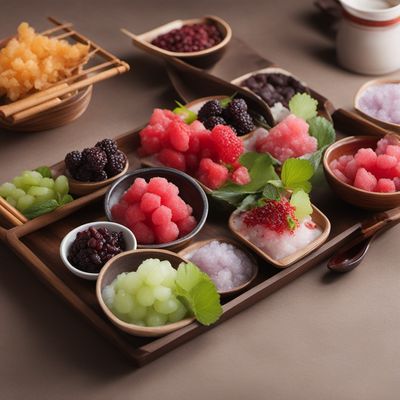
Ingredient
Condensed milk (sometimes with added sugars)
The Creamy Sweetness: Condensed Milk Delight
Condensed milk is made by removing most of the water content from regular milk and adding sugar, resulting in a thick and sticky consistency. It has a rich and creamy taste with a pronounced sweetness. The texture is smooth and velvety, making it ideal for creating creamy desserts like fudge, ice cream, and puddings. It can also be used as a sweetener in coffee, tea, or cocktails.
Origins and history
The invention of condensed milk is credited to Gail Borden, an American inventor, who patented the process in the mid-19th century. Condensed milk gained popularity as a convenient and long-lasting alternative to fresh milk, especially during times when refrigeration was not widely available. It became a staple ingredient in many households and was used in various recipes around the world.
Nutritional information
Condensed milk is high in calories and sugar. It is a good source of calcium and provides some protein and vitamins. However, due to its high sugar content, it should be consumed in moderation as part of a balanced diet.
Allergens
Condensed milk may contain lactose, making it unsuitable for individuals with lactose intolerance or dairy allergies. It is important to read the label and check for any added ingredients that may cause allergic reactions.
How to select
When selecting condensed milk, choose reputable brands that use high-quality ingredients. Check the label for any added sugars or flavors, as some varieties may have additional ingredients. It is also important to check the expiration date to ensure freshness.
Storage recommendations
To maintain the freshness of condensed milk, store it in a cool and dry place, away from direct sunlight. Once opened, it should be refrigerated and consumed within a few days. It is important to keep the container tightly sealed to prevent the milk from absorbing any odors or flavors from the refrigerator.
How to produce
Condensed milk is produced by evaporating most of the water content from regular milk and adding sugar. This process can be done at home using a double boiler or by using a specialized machine. However, it is more commonly produced on an industrial scale by dairy companies.
Preparation tips
Condensed milk can be used as a base for various desserts like fudge, ice cream, and custards. It can also be drizzled over pancakes, waffles, or fresh fruits for added sweetness. In beverages, condensed milk is commonly used in coffee, tea, or cocktails to enhance the flavor and provide a creamy texture.
Substitutions
Evaporated milk can be used as a substitute for condensed milk by adding sugar to achieve a similar sweetness. Alternatively, you can make a homemade version of condensed milk by simmering regular milk with sugar until it reduces and thickens.
Culinary uses
Condensed milk is widely used in desserts and beverages around the world. It is a key ingredient in dishes like tres leches cake, dulce de leche, and Vietnamese iced coffee. It is also commonly used in Southeast Asian cuisines, particularly in desserts like halo-halo and Thai iced tea.
Availability
Condensed milk is commonly available in most supermarkets and grocery stores worldwide. It is also widely used in various cuisines, including Latin American, Southeast Asian, and Indian cuisines.
More ingredients from this category
Recipes using Condensed milk (sometimes with added sugars) » Browse all

Passion Fruit Mousse
Tropical Delight: Passion Fruit Mousse

Homemade Mango Kulfi
Mango Delight Kulfi: A Tropical Twist to the Traditional Indian Dessert

Indian Chinese Style Torta della Nonna
Spicy Fusion Delight: Indian Chinese Style Torta della Nonna

Baobing - Chinese Shaved Ice Dessert
Frosty Delight: A Refreshing Twist on Chinese Shaved Ice

Philadelphia-style Tipsy Cake
Boozy Delight: Philadelphia-style Tipsy Cake

Kuwaiti-inspired Gypsy Tart
Kuwaiti Delight: A Sweet Journey with Gypsy Tart

Haitian Coconut Bonbons
Tropical Delights: Haitian Coconut Bonbons

Banoffee Delight
Decadent Caramel Banana Pie

Ngalakh Delight
Divine Delicacy: Ngalakh - A Senegalese Sweet Sensation

Suspiro de Veracruz
Veracruzian Delight: A Sweet Symphony of Flavors

Mexican Potato Candy
Spicy Sweet Delight: Mexican Potato Candy

Salvadoran Mazuryky: A Fusion of Ukrainian and Salvadoran Flavors
Tropical Twist: Salvadoran Mazuryky with a Ukrainian Touch
